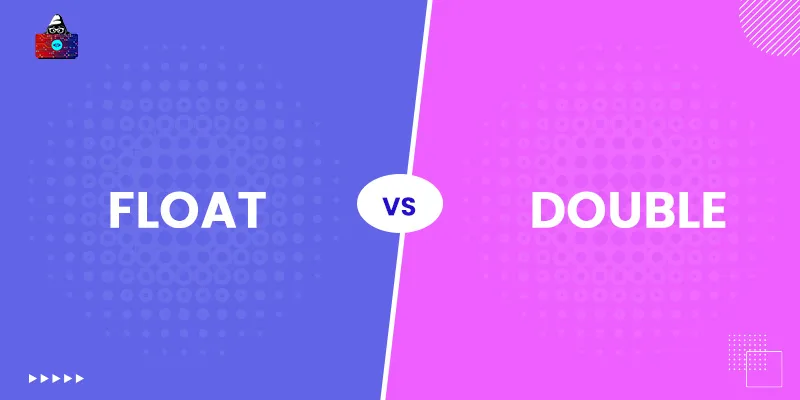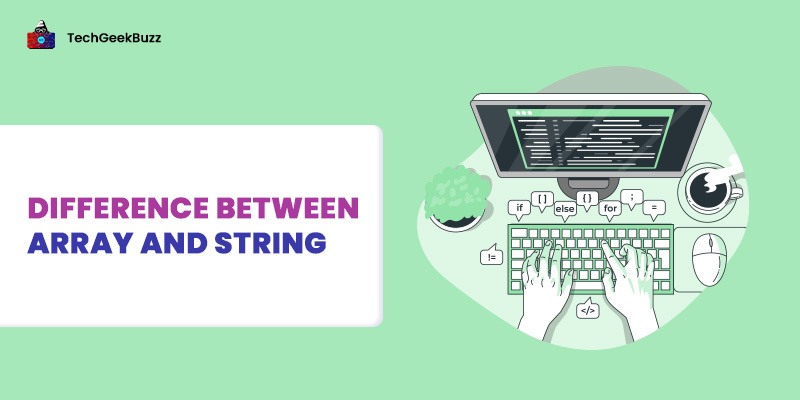Confused between the two data types – float and double – and don’t understand which one to use? Continue reading this article to understand the differences between float vs double.
Every programming language offers different types to store different types of data. For instance, int to store integer values ( whole numbers ), char to store characters, etc. In programming languages like C, C++ and Java , we have two primitive data types – float and double – to store floating-point or decimal numbers.
Examples of floating point numbers - 10.765847, 34.56473, 24.6745, etc.
Many novice programmers have a question - what is the difference between float and double if they both store floating-point numbers?
The major difference between float and double lies in the precision. Precision refers to accuracy. In data science or scientific computing, precision plays a vital role. Even a single decimal point can have a huge impact. As a result, a programmer should be very careful in using float and double data types.
While float has 7 decimal places of precision, double has 14 decimal places of precision. Besides this, float and double differ in many ways.
This blog post will walk through some major differences between float vs double. It will help you understand when to use these data types in your program .
Float vs Double: A Head-to-Head Comparison
The following table highlights the differences between float and double:
|
Parameters |
Float |
Double |
|
Explanation |
Float is a single-precision primitive floating-point data type. |
Double is a double-precision primitive floating-point data type. |
|
Significant Bits |
Float stores up to 7 significant bits. If these bits exceed more than 7, they are rounded off. |
Double stores up to 15 significant bits. |
|
Precision |
It has 7 decimal digits of precision. |
It has 15 decimal digits of precision. |
|
Memory |
Float occupies 4 bytes or 32 bits of memory space. |
Double occupies 8 bytes or 64 bits of memory space. |
|
Format Specifier |
It uses %f as the format specifier. |
It uses %d as the format specifier. |
|
Range |
The range of the float data type is 3.4e-038 to 3.4e+038. |
The range of the double data type is 1.7e-308 to 1.7e+308. |
|
Data Loss |
There is no data loss if you convert any float value into double. |
If you convert any double value into a float, it results in data loss. |
|
Cost |
It is less expensive in terms of memory usage. |
It is more costly in terms of memory usage. |
|
Application |
If there is no need for higher precision, using float is ideal. |
When precision is paramount, double comes in handy. It avoids data compression or loss of bits. |
|
Advantages |
|
It is more precise than float. |
What is a Float?
Float is a single-precision floating-point data type that represents floating-point numbers. It usually occupies 32 bits or 4 bytes in the computer memory.
32 bits = 1 bit for the Sign + 8 bits for the exponent + 23 bits for the value.
Float follows the IEEE 754 standard and supports up to 7 digits of precision after the decimal. An integer can have a maximum value of 2,147,483,647, whereas a float can have a maximum value of 3.4028235 × 1038.
Note: IEEE 754 is a standard representation of floating-point numbers in a computer.
Using a float is the best choice if you want to use memory efficiently while writing programs or have a number in a small range.
We use the keyword float to define a floating-point value.
C
float variable_name = value;
C++/Java
float variable_name = valuef;
or
float variable_name = valueF;
Note: Java and C++, by default, treat any floating-point or decimal number as double. If you want to defile a floating-point value, you need to use typecasting. This means you need to convert double into float using the suffix ‘f’ or ‘F’ after the value.
What is Double?
Double is also an IEEE 754 standard primitive data type with higher precision. It is a double-precision floating-point data type to represent floating-point or decimal numbers. It occupies 8 bytes or 64 bits.
64 bits = 1 bit for the Sign + 11 bits for the exponent + 52 bits for the value.
Double supports up to 15 digits of precision after the decimal. It shows more precision and occupies more memory than the float data type. The precision signifies the accuracy of the result.
So, if you need to perform complex scientific calculations where accuracy matters the most, use double as the data type instead of float.
To define a double value, we use the keyword double .
C/C++
double variable_name = value;
Java
double variable_name = value;
or
double variable_name = valued;
or
double variable_name = valueD;
Why Use Float and Double?
The main reason behind using floating-point numbers is accuracy. In arithmetic operations, we often come across such computational results where the digits after the decimal points are infinite and cannot be represented using any data type.
For example, 2/3 (which goes on endlessly to 0.666666...). Float and double data types round up the decimal points after a certain limit for such infinite decimal digits.
Although rounding up such real numbers does the task for us in most cases, think of scientific computation, where a single decimal difference can greatly impact the overall result. In those cases, we require data types that have more precision and store more decimal digits.
Both double and float do not provide full accuracy and precision, but between the two, double comes out on top with more precision. That's why C++ also provides the long double data type for better accuracy of floating-point numbers.
Float vs Double – Key Differences
Before we throw light on the differences, let us first understand the similarities between float and double.
Similarities Between Float and Double
- Both float and double data types store real numbers with decimal points or fractions in them. For instance, 4.567, 3.908, 34.5647, etc.
- They store approximate values and are not precise. However, when compared between float and double, double has an edge over float.
Difference Between Float and Double
Let us now discuss the differences between float and double in detail.
1. Byte Size
The foremost difference between float and double lies in the byte size. While float occupies 4 bytes or 32 bits, double occupies 8 bytes or 64 bits.
We can cross-check this using the sizeof() method.
Code
#include <iostream>
using namespace std;
int main() {
cout << "float: " << sizeof(float) << endl;
cout << "double: " << sizeof(double) << endl;
return 0;
}
Output
float: 4
double: 8
Double occupies more memory space, i.e., twice the float consumes.
2. Precision
As float and double have different byte sizes, the number of decimal digits they hold is also different.
Float supports 7 digits after the decimal point, whereas double supports 16 digits after the decimal point. Hence, double has higher precision than float.
Let us understand this using an example in C++.
Example
#include <iomanip>
#include <iostream>
using namespace std;
int main() {
double value1 = 10.34536278463;
float value2 = 10.34536278463;
cout << setprecision(8);
cout <<"Double Value: "<<value1 << endl;
cout <<"Float Value: "<<value2 << endl;
return 0;
}
Output
Double Value: 10.34536278
Float Value: 10.34536276
In the above example, you can see that the double value is more precise than the float value. We have used setprecision() to tell the compiler the number of digitals we want to print after the decimal point.
You can see that the float value is accurate up to 7 digitals after the decimal point and changes after that. However, the double is the same as we defined in the program.
3. Usage
Float is generally used in graphics libraries because it has a small range and occupies less memory space. Hence, it facilitates high processing power.
On the other hand, double is used in scientific calculations and computations where accuracy matters the most. It helps eliminate any errors in computation results. When you use float for large decimal values, the result after 7 digits is rounded off. This may affect the accuracy. However, double support the precision of up to 15 digits, which can gaurantee accuracy for values with 15 decimal numbers.
4. Default Data Type
Java and C++ programming languages use double as their default data type. When you use floating-point numbers in Java or C++, it considers their data type as double. Hence, you need to perform typecasting to convert double into float explicitly. This is achieved by adding ‘F’ or ‘f’ as a suffix to a value.
When to Use Float?
We generally use the float data type with a low-scale program where point accuracy does not matter that much. It has less size and occupies only 32 bits of memory, which makes it very fast to compute. If you want to make a program as small as possible, you should use float data type for floating-point numbers.
When to Use Double?
When writing code for high-end computers where RAM consumption and battery drainage are not the major issues, you should use the double data type. Double provides more range and precision as compared to float. Therefore, if accuracy is your main concern, you should use the double data type.
Conclusion
Float and double are the two most confusing data types of programming languages like C, C++, and Java. In most cases, it does not matter whether you use float or double. These days, we do not have to worry about the size of a data variable because we have high-processing CPUs with multiple cores nowadays.
On the other hand, precision can be the major reason for shifting the data type from float to double. In other programming languages like JavaScript, PHP, and Python, we do not have dedicated data types for floating-point numbers. There, we only get the float data type.
People are also reading:





Leave a Comment on this Post